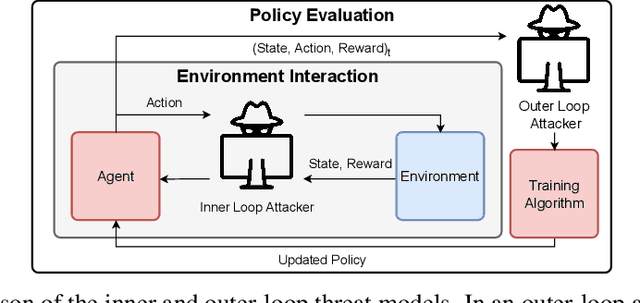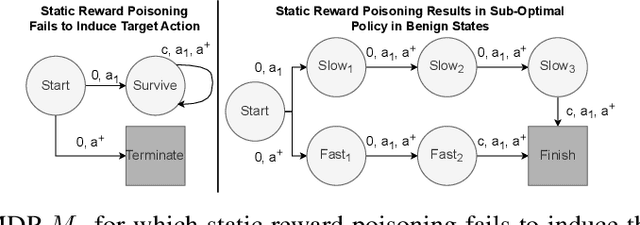Alina Oprea
PoolFlip: A Multi-Agent Reinforcement Learning Security Environment for Cyber Defense
Aug 27, 2025Abstract:Cyber defense requires automating defensive decision-making under stealthy, deceptive, and continuously evolving adversarial strategies. The FlipIt game provides a foundational framework for modeling interactions between a defender and an advanced adversary that compromises a system without being immediately detected. In FlipIt, the attacker and defender compete to control a shared resource by performing a Flip action and paying a cost. However, the existing FlipIt frameworks rely on a small number of heuristics or specialized learning techniques, which can lead to brittleness and the inability to adapt to new attacks. To address these limitations, we introduce PoolFlip, a multi-agent gym environment that extends the FlipIt game to allow efficient learning for attackers and defenders. Furthermore, we propose Flip-PSRO, a multi-agent reinforcement learning (MARL) approach that leverages population-based training to train defender agents equipped to generalize against a range of unknown, potentially adaptive opponents. Our empirical results suggest that Flip-PSRO defenders are $2\times$ more effective than baselines to generalize to a heuristic attack not exposed in training. In addition, our newly designed ownership-based utility functions ensure that Flip-PSRO defenders maintain a high level of control while optimizing performance.
Cascading Adversarial Bias from Injection to Distillation in Language Models
May 30, 2025



Abstract:Model distillation has become essential for creating smaller, deployable language models that retain larger system capabilities. However, widespread deployment raises concerns about resilience to adversarial manipulation. This paper investigates vulnerability of distilled models to adversarial injection of biased content during training. We demonstrate that adversaries can inject subtle biases into teacher models through minimal data poisoning, which propagates to student models and becomes significantly amplified. We propose two propagation modes: Untargeted Propagation, where bias affects multiple tasks, and Targeted Propagation, focusing on specific tasks while maintaining normal behavior elsewhere. With only 25 poisoned samples (0.25% poisoning rate), student models generate biased responses 76.9% of the time in targeted scenarios - higher than 69.4% in teacher models. For untargeted propagation, adversarial bias appears 6x-29x more frequently in student models on unseen tasks. We validate findings across six bias types (targeted advertisements, phishing links, narrative manipulations, insecure coding practices), various distillation methods, and different modalities spanning text and code generation. Our evaluation reveals shortcomings in current defenses - perplexity filtering, bias detection systems, and LLM-based autorater frameworks - against these attacks. Results expose significant security vulnerabilities in distilled models, highlighting need for specialized safeguards. We propose practical design principles for building effective adversarial bias mitigation strategies.
R1dacted: Investigating Local Censorship in DeepSeek's R1 Language Model
May 19, 2025Abstract:DeepSeek recently released R1, a high-performing large language model (LLM) optimized for reasoning tasks. Despite its efficient training pipeline, R1 achieves competitive performance, even surpassing leading reasoning models like OpenAI's o1 on several benchmarks. However, emerging reports suggest that R1 refuses to answer certain prompts related to politically sensitive topics in China. While existing LLMs often implement safeguards to avoid generating harmful or offensive outputs, R1 represents a notable shift - exhibiting censorship-like behavior on politically charged queries. In this paper, we investigate this phenomenon by first introducing a large-scale set of heavily curated prompts that get censored by R1, covering a range of politically sensitive topics, but are not censored by other models. We then conduct a comprehensive analysis of R1's censorship patterns, examining their consistency, triggers, and variations across topics, prompt phrasing, and context. Beyond English-language queries, we explore censorship behavior in other languages. We also investigate the transferability of censorship to models distilled from the R1 language model. Finally, we propose techniques for bypassing or removing this censorship. Our findings reveal possible additional censorship integration likely shaped by design choices during training or alignment, raising concerns about transparency, bias, and governance in language model deployment.
ACE: A Security Architecture for LLM-Integrated App Systems
Apr 29, 2025



Abstract:LLM-integrated app systems extend the utility of Large Language Models (LLMs) with third-party apps that are invoked by a system LLM using interleaved planning and execution phases to answer user queries. These systems introduce new attack vectors where malicious apps can cause integrity violation of planning or execution, availability breakdown, or privacy compromise during execution. In this work, we identify new attacks impacting the integrity of planning, as well as the integrity and availability of execution in LLM-integrated apps, and demonstrate them against IsolateGPT, a recent solution designed to mitigate attacks from malicious apps. We propose Abstract-Concrete-Execute (ACE), a new secure architecture for LLM-integrated app systems that provides security guarantees for system planning and execution. Specifically, ACE decouples planning into two phases by first creating an abstract execution plan using only trusted information, and then mapping the abstract plan to a concrete plan using installed system apps. We verify that the plans generated by our system satisfy user-specified secure information flow constraints via static analysis on the structured plan output. During execution, ACE enforces data and capability barriers between apps, and ensures that the execution is conducted according to the trusted abstract plan. We show experimentally that our system is secure against attacks from the INJECAGENT benchmark, a standard benchmark for control flow integrity in the face of indirect prompt injection attacks, and our newly introduced attacks. Our architecture represents a significant advancement towards hardening LLM-based systems containing system facilities of varying levels of trustworthiness.
SAGA: A Security Architecture for Governing AI Agentic Systems
Apr 27, 2025Abstract:Large Language Model (LLM)-based agents increasingly interact, collaborate, and delegate tasks to one another autonomously with minimal human interaction. Industry guidelines for agentic system governance emphasize the need for users to maintain comprehensive control over their agents, mitigating potential damage from malicious agents. Several proposed agentic system designs address agent identity, authorization, and delegation, but remain purely theoretical, without concrete implementation and evaluation. Most importantly, they do not provide user-controlled agent management. To address this gap, we propose SAGA, a Security Architecture for Governing Agentic systems, that offers user oversight over their agents' lifecycle. In our design, users register their agents with a central entity, the Provider, that maintains agents contact information, user-defined access control policies, and helps agents enforce these policies on inter-agent communication. We introduce a cryptographic mechanism for deriving access control tokens, that offers fine-grained control over an agent's interaction with other agents, balancing security and performance consideration. We evaluate SAGA on several agentic tasks, using agents in different geolocations, and multiple on-device and cloud LLMs, demonstrating minimal performance overhead with no impact on underlying task utility in a wide range of conditions. Our architecture enables secure and trustworthy deployment of autonomous agents, accelerating the responsible adoption of this technology in sensitive environments.
Quantitative Resilience Modeling for Autonomous Cyber Defense
Mar 04, 2025Abstract:Cyber resilience is the ability of a system to recover from an attack with minimal impact on system operations. However, characterizing a network's resilience under a cyber attack is challenging, as there are no formal definitions of resilience applicable to diverse network topologies and attack patterns. In this work, we propose a quantifiable formulation of resilience that considers multiple defender operational goals, the criticality of various network resources for daily operations, and provides interpretability to security operators about their system's resilience under attack. We evaluate our approach within the CybORG environment, a reinforcement learning (RL) framework for autonomous cyber defense, analyzing trade-offs between resilience, costs, and prioritization of operational goals. Furthermore, we introduce methods to aggregate resilience metrics across time-variable attack patterns and multiple network topologies, comprehensively characterizing system resilience. Using insights gained from our resilience metrics, we design RL autonomous defensive agents and compare them against several heuristic baselines, showing that proactive network hardening techniques and prompt recovery of compromised machines are critical for effective cyber defenses.
DROP: Poison Dilution via Knowledge Distillation for Federated Learning
Feb 10, 2025



Abstract:Federated Learning is vulnerable to adversarial manipulation, where malicious clients can inject poisoned updates to influence the global model's behavior. While existing defense mechanisms have made notable progress, they fail to protect against adversaries that aim to induce targeted backdoors under different learning and attack configurations. To address this limitation, we introduce DROP (Distillation-based Reduction Of Poisoning), a novel defense mechanism that combines clustering and activity-tracking techniques with extraction of benign behavior from clients via knowledge distillation to tackle stealthy adversaries that manipulate low data poisoning rates and diverse malicious client ratios within the federation. Through extensive experimentation, our approach demonstrates superior robustness compared to existing defenses across a wide range of learning configurations. Finally, we evaluate existing defenses and our method under the challenging setting of non-IID client data distribution and highlight the challenges of designing a resilient FL defense in this setting.
Adversarial Inception for Bounded Backdoor Poisoning in Deep Reinforcement Learning
Oct 21, 2024Abstract:Recent works have demonstrated the vulnerability of Deep Reinforcement Learning (DRL) algorithms against training-time, backdoor poisoning attacks. These attacks induce pre-determined, adversarial behavior in the agent upon observing a fixed trigger during deployment while allowing the agent to solve its intended task during training. Prior attacks rely on arbitrarily large perturbations to the agent's rewards to achieve both of these objectives - leaving them open to detection. Thus, in this work, we propose a new class of backdoor attacks against DRL which achieve state of the art performance while minimally altering the agent's rewards. These "inception" attacks train the agent to associate the targeted adversarial behavior with high returns by inducing a disjunction between the agent's chosen action and the true action executed in the environment during training. We formally define these attacks and prove they can achieve both adversarial objectives. We then devise an online inception attack which significantly out-performs prior attacks under bounded reward constraints.
Model-agnostic clean-label backdoor mitigation in cybersecurity environments
Jul 11, 2024



Abstract:The training phase of machine learning models is a delicate step, especially in cybersecurity contexts. Recent research has surfaced a series of insidious training-time attacks that inject backdoors in models designed for security classification tasks without altering the training labels. With this work, we propose new techniques that leverage insights in cybersecurity threat models to effectively mitigate these clean-label poisoning attacks, while preserving the model utility. By performing density-based clustering on a carefully chosen feature subspace, and progressively isolating the suspicious clusters through a novel iterative scoring procedure, our defensive mechanism can mitigate the attacks without requiring many of the common assumptions in the existing backdoor defense literature. To show the generality of our proposed mitigation, we evaluate it on two clean-label model-agnostic attacks on two different classic cybersecurity data modalities: network flows classification and malware classification, using gradient boosting and neural network models.
SleeperNets: Universal Backdoor Poisoning Attacks Against Reinforcement Learning Agents
May 30, 2024



Abstract:Reinforcement learning (RL) is an actively growing field that is seeing increased usage in real-world, safety-critical applications -- making it paramount to ensure the robustness of RL algorithms against adversarial attacks. In this work we explore a particularly stealthy form of training-time attacks against RL -- backdoor poisoning. Here the adversary intercepts the training of an RL agent with the goal of reliably inducing a particular action when the agent observes a pre-determined trigger at inference time. We uncover theoretical limitations of prior work by proving their inability to generalize across domains and MDPs. Motivated by this, we formulate a novel poisoning attack framework which interlinks the adversary's objectives with those of finding an optimal policy -- guaranteeing attack success in the limit. Using insights from our theoretical analysis we develop ``SleeperNets'' as a universal backdoor attack which exploits a newly proposed threat model and leverages dynamic reward poisoning techniques. We evaluate our attack in 6 environments spanning multiple domains and demonstrate significant improvements in attack success over existing methods, while preserving benign episodic return.
 Add to Chrome
Add to Chrome Add to Firefox
Add to Firefox Add to Edge
Add to Edge